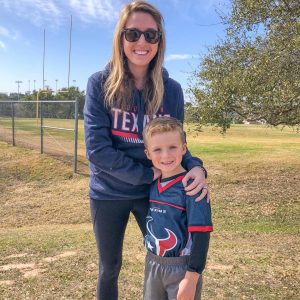How I Protect My Blindside From Friedreich’s Ataxia

My healthy, rambunctious, and handsome 6-year-old son, Brooks, started his second flag football season this month. He scored two touchdowns this weekend, and I was beyond proud of him. He is such a hard worker who continually amazes me.
Having grown up in Texas, football has always been a big part of my life. I have respect for the sport and love cheering for my teams. Although I have strong objections to Brooks playing tackle football for fear of injury, I have really enjoyed watching him learn and grow in a team sport.
I couldn’t help but chuckle when the boys were shocked at having their flags pulled by someone they didn’t even see coming. I was talking to someone on the sidelines about how the kids don’t grasp the concept of their “blindside,” which is understandable, considering they are mostly preschoolers or kindergartners. Yet, this got me thinking about all of the times I’ve felt blindsided in my life.
The time that I felt most blindsided was in 2013. I was in a medical exam room, and my neurologist told me, “I’m sorry to say, but you have Friedreich’s ataxia (FA).” I had never even heard of FA, let alone prepared to wage a lifelong battle against this progressively degenerative disease. I was blindsided — knocked down and breathless. It was especially confusing because I hadn’t even seen it coming.
So, what do you do after you are taken down from your blindside? You get back up and make a plan to protect your blindside better next time.
Now that I had my FA diagnosis and my body had already started deteriorating due to my FA symptom progression, I had to prepare to fight against my opponent.
It’s like the football game that won’t end. I don’t have a season, and there is no second-strongest player to fill in for me. There are no halftimes or timeouts. FA is a relentless opponent that only grows stronger and more challenging. But I fight every single minute of every single day not to let FA knock me out.
I use a walker to protect me from falls. I eat healthily to fuel my body to keep going. I exercise to stay strong. I go to physical therapy to improve whatever I can. I rest whenever possible and go to bed early to help fight fatigue with sleep.
All of that helps me physically fight FA. As the years have passed and my symptoms have progressed, FA has become as much of a mental and emotional opponent as it is a physical one. So, I fight to protect my blindside there, too.
I seek advice from veteran FA patients. I share openly with my loved ones. I follow guidance from mentors and professionals. I allow myself to feel whatever I feel, and then I fight to get back into a healthy headspace to move forward with life.
Protecting my blindside from FA is a time-consuming task, but it’s worth the effort. And the greatest team has assembled to help me (and the rest of the FA community) fight. Team Kendall has raised funds and awareness, all in the name of helping advance the medical fields to aid us with treatments and a cure. They are my biggest cheerleaders, supporters, and encouragers. I might be the one personally fighting FA, but I am not fighting alone.
As Ron Bartek, the president, co-founder, and director of the Friedreich’s Ataxia Research Alliance said, “Acting alone, there is very little any of us can accomplish. Acting together, there is very little we will not accomplish!”
***
Friedreich’s Ataxia News is strictly a news and information website about the disease. It does not provide medical advice, diagnosis or treatment. This content is not intended to be a substitute for professional medical advice, diagnosis, or treatment. Always seek the advice of your physician or another qualified health provider with any questions you may have regarding a medical condition. Never disregard professional medical advice or delay in seeking it because of something you have read on this website.The opinions expressed in this column are not those of Friedreich’s Ataxia News or its parent company, Bionews, and are intended to spark discussion about issues pertaining to Friedreich’s ataxia.








Leave a comment
Fill in the required fields to post. Your email address will not be published.